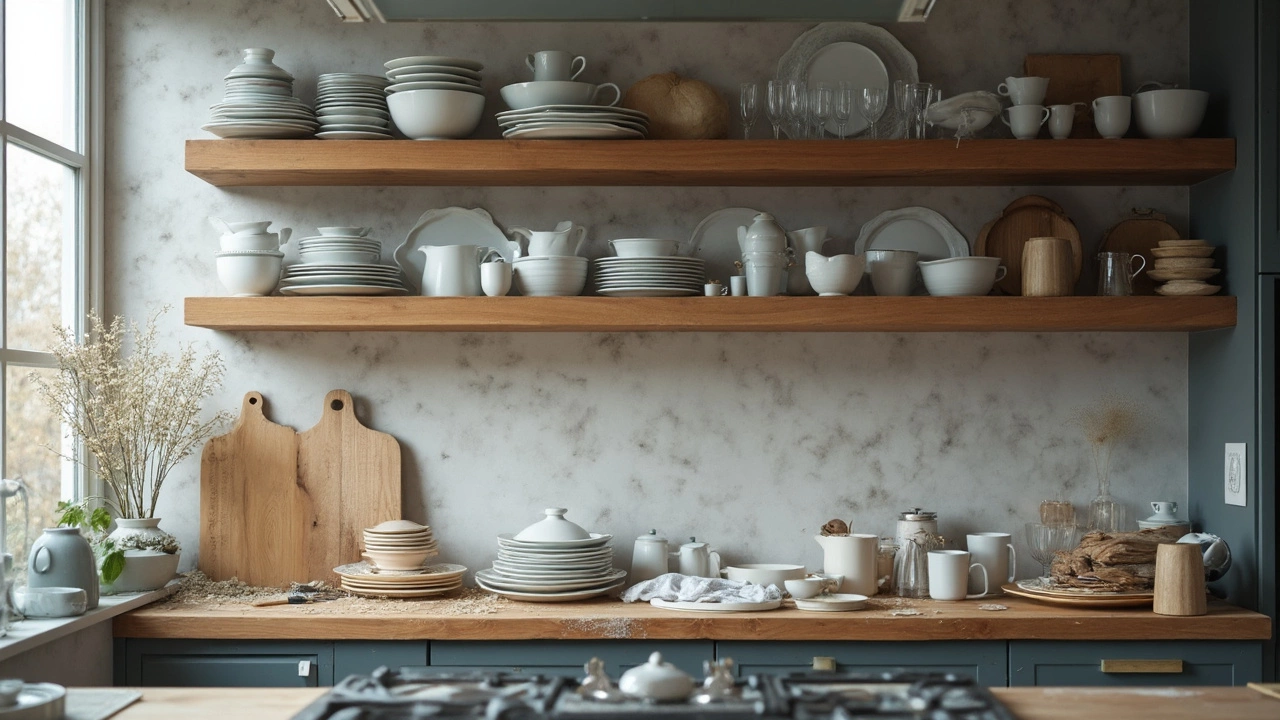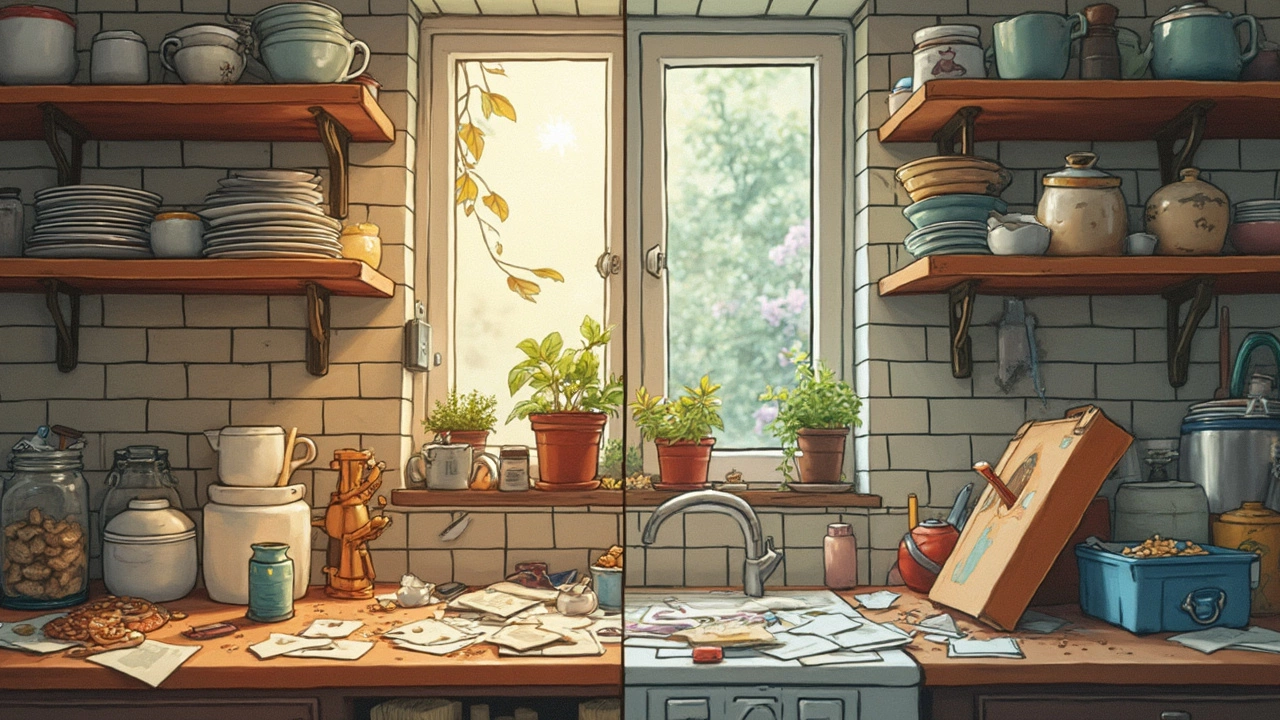Open Shelves Disadvantages: What You Need to Know Before Installing
 Jun, 6 2025
Jun, 6 2025
That beautiful row of open shelves in your friend’s kitchen? Looks dreamy on Instagram—until you hear about the endless dusting. Open shelving comes with a big cleaning commitment. Everything from your plates to your favorite mug is exposed, and dust doesn’t take a day off. If you think you can just wipe them down once a month, think again. Even if you use those plates every day, anything left out facing subway tile will gather grime faster than you expect.
If you’re the kind of person who shoves a mismatched cup into the back of a cabinet and forgets about it, open shelves will force you to change your habits. Organization isn’t optional when everything is on display. The moment you let a few items pile up, the whole setup looks messy and chaotic. No more hiding cracked mugs or souvenir plates behind closed doors—the world can see your kitchen secrets now.
- Dust and Cleaning Nightmares
- Clutter and Visual Overload
- Safety and Stability Issues
- Making Open Shelves Work Better
Dust and Cleaning Nightmares
If you go with open shelves, get ready for more cleaning. With no doors to block out dust, your dishes, glasses, cookbooks, and even pantry items are always exposed. In most kitchens, dust plus grease from cooking quickly starts to build up. Some cleaning experts say open shelves need wiping down at least once a week, while closed cabinets can go a month or more without attention.
It's not just dust, either. Grease particles from your stove float through the air and land on whatever's sitting out. Over time, this creates a stubborn, sticky layer that's tough to clean. According to a small kitchen study, surfaces on open shelves near stoves had about two times more oily residue than inside closed cabinets.
Here's a look at what you can expect to deal with on open shelving, especially in kitchens:
- Weekly dusting—sometimes more if you live with pets or near a busy street
- Wiping down every item on the shelf, not just the shelf itself
- Extra effort to keep glassware and dishes looking spotless
- Grease buildup that requires stronger cleaners, particularly above or near cooking areas
Check out how the dust and residue situation compares between open shelves and closed cabinets:
| Storage Type | Average Dust Accumulation (mg/ft² per week) | Cleaning Frequency |
|---|---|---|
| Open Shelves | 13.2 | Weekly |
| Closed Cabinets | 5.6 | Monthly |
If you're planning to use open shelves for things you don't touch every day, like special bowls or holiday mugs, those items will collect a noticeable film and may even end up smelling stale after a while. For anyone who isn’t up for regular cleaning sessions, the open shelves trend can quickly turn from stylish to stressful.
Clutter and Visual Overload
If you’re not a naturally tidy person, open shelves are a recipe for open shelves regret. The lack of doors means everything is on show—the good, the ugly, and the stuff you wish you’d tossed out years ago. Your counters aren’t the only thing getting busy; your eyes do, too. In one 2023 consumer survey, 68% of people with open shelving said their spaces looked messier than before, even when everything was technically organized.
The biggest problem here is visual clutter. Too many colors, shapes, or random items up top? It gets overwhelming fast. Stuff that had a home behind solid cabinets—a chipped mug, the cereal box, dog treats—now demands attention, turning a kitchen or living room into a messy display. What was supposed to be stylish ends up looking like a yard sale on your wall.
Here’s why visual overload is a real problem:
- It makes spaces feel smaller, even when they’re not physically crowded.
- It’s distracting. In a 2022 organizational psychology study, people reported higher stress in rooms with visible clutter.
- You waste time searching for things among crowded or mismatched shelves.
Visual clutter isn’t just a vibe killer—it affects your daily mood and productivity. If every time you step into the kitchen, there’s a jumble of colors and shapes on the shelves, it’s hard to relax or focus on cooking.
| Problem | Reported Impact (%) |
|---|---|
| Feeling of clutter | 68 |
| Difficulty finding items | 47 |
| Increased cleaning | 55 |
| Unwanted spotlight on unused items | 33 |
Here’s a tip: If you already have open shelves but want to avoid the cluttered look, pick one or two colors for dishes and storage bins. Keep only the stuff you actually use. Rotate or swap items as seasons change. A minimalist setup can make open shelves work, but you’ve got to be picky about what earns a spot out in the open.

Safety and Stability Issues
Let’s be real: open shelves aren’t always as sturdy as they look in design magazines. When it comes to open shelves, there’s way more to worry about than just what you put on them. If you overload a shelf (and honestly, who hasn’t?), you risk things crashing down or even pulling the hardware right out of the wall. Heavy items like glass jars and dishes—typical kitchen stuff—raise the risk if the anchors and brackets can’t actually handle the weight.
It’s not just about the type of wall, either. Even well-mounted shelves can become unstable over time if you stack them badly, move items around a lot, or bump into them. And if you’ve got kids or even a jumpy cat in the house, think about how easy it is for someone to accidentally knock stuff off those shelves. A falling mug is annoying, but a falling mixer bowl could send you on an ER trip.
If you’re planning on installing open shelving, it helps to know the numbers. Check this out:
| Bracket Type | Safe Weight Limit |
|---|---|
| Basic Floating Bracket | 10-20 lbs per foot |
| Heavy-Duty Angle Bracket | 30-50 lbs per foot |
| Cheap Plastic Support | 5-10 lbs per foot |
When people grab cheap brackets or don’t use wall studs, shelves start sagging—and the next person who leans on them or grabs a dish could send everything tumbling. That’s why professionals always recommend using heavy-duty anchors, securing to studs wherever possible, and keeping heavy items near the wall and lighter stuff on the outside. Got a shelf above a kid’s desk or a pet’s food bowl? Best not to put anything heavy or fragile up there at all.
One smart move: give each shelf a gentle shake after installation, and see if it wobbles or shifts. Fix any loose hardware right away. And resist the urge to crowd every square inch—the more packed your shelves are, the higher the risk of something slipping or falling.
Making Open Shelves Work Better
If you’ve already committed to open shelves or just can’t resist the look, there are ways to dodge the main headaches. First thing—be picky with what you display. Only put things you use all the time on those shelves. Stuff that stays in heavy rotation (like your cereal bowls or coffee mugs) won’t sit long enough to collect serious dust.
Don’t treat your open shelves like storage for everything. Use them for daily dishware, not your once-a-year waffle iron. If you want your kitchen to look tidy, leave some space between items. Crowding everything together just makes it look more chaotic.
- Stick to a color scheme or matching sets. Mismatched plastics and kids’ cups belong in the cabinets.
- Give everything on your shelves a regular rinse or wipe-down—once a week isn’t overkill.
- Add baskets or bins for small stuff, like spice jars. Just pick solid-sided containers so you don’t see the mess inside.
Kitchens with open shelving are proven to need more cleaning. According to a 2023 survey from HomeAdvisor, homes with open shelves in the kitchen require up to twice the weekly dusting compared to those with only closed cabinets. Here’s what that looks like in real life:
| Type of Shelving | Average Cleaning Time/Week |
|---|---|
| Open Shelves | 30 minutes |
| Closed Cabinets | 15 minutes |
Afraid your shelves are starting to sag? Use metal or sturdy brackets; cheaper plastic supports may not cut it for heavy stacks of plates. And keep your heavier stuff on the bottom shelf—no one wants a flying casserole dish overhead.
Lighting can help too. LED strip lights make shelves look tidier and help you spot dust or dripping oil faster. Just make sure any electrical setup is kitchen-safe.
Treating open shelves as a kind of functional display—not a dumping ground—keeps your space organized without tons of stress. With a routine and a few quick tweaks, you get that magazine-worthy look without it taking over your life.